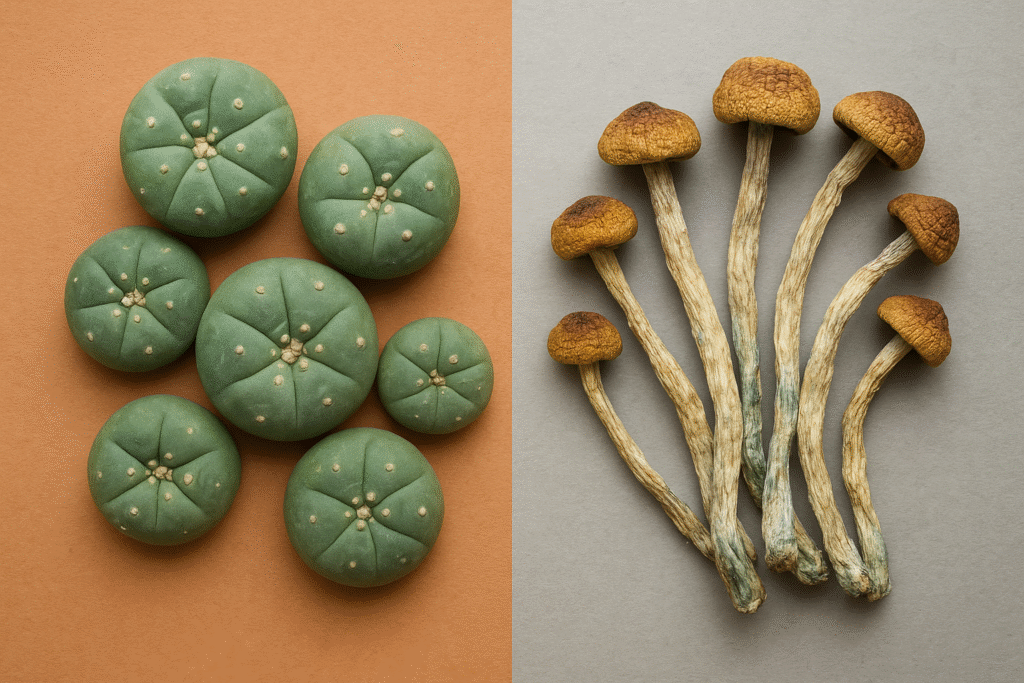Reading Time: ~8 minutes
Across centuries and cultures, peyote and psilocybin have guided humans through deep healing, revelation, and connection with the sacred. Though their origins differ, one a resilient desert cactus, the other a humble forest mushroom, both open the heart and expand awareness in profound ways.
Psychedelics have been a part of human culture for centuries, often used in sacred ceremonies for healing and spiritual insight. Among these medicines, peyote and psilocybin stand out for their rich cultural histories and unique effects on the human mind.
This article explores peyote vs psilocybin, their origins, mechanisms, therapeutic potential, subjective experiences, and the ethical considerations surrounding their use. Whether you are a psychonaut, a spiritual seeker, or simply curious, this comparison will help you make an informed choice on your journey.
Understanding Peyote and Psilocybin: Roots of Two Ancient Medicines
When comparing psilocybin vs peyote, it’s important to recognize that both substances are natural psychedelics, but their effects, duration, and cultural contexts differ substantially.
Peyote – The Spirit Teacher
Peyote is a small cactus native to North America, containing the psychedelic alkaloid mescaline. Used for centuries by Indigenous peoples, peyote plays a central role in ceremonial and spiritual practices, often described as a plant teacher that offers deep emotional and spiritual insight.
Peyote is regarded not merely as a plant, but as a spirit being: a wise teacher in living form. In traditional ceremonies, the journey is guided by a shaman or elder who holds sacred space through prayer, song, and ritual.
It’s important to recognize that peyote is endangered in the wild, and that non-Indigenous use remains a sensitive and often controversial topic that calls for deep respect and cultural awareness.
Psilocybin – Flesh of the Gods
Psilocybin, the active compound in magic mushrooms and truffles, has a long history of use in Mesoamerican traditions. Today, it is one of the most studied psychedelics in modern science, showing significant therapeutic promise for mental health conditions.
For centuries, the Mazatec people of Mexico have used teonanácatl, the “flesh of the gods”, in sacred rituals led by curanderos and curanderas. These mushroom ceremonies were never about recreation; they were acts of reverence, healing, and communion with the divine. Participants sought guidance, clarity, and connection to the unseen world through the wisdom of the mushrooms.
In recent decades, the Western world has witnessed a “psychedelic renaissance”. Psychedelic research and guided retreats are, in many ways, rediscovering what Indigenous traditions have long known: that these natural medicines can open the mind, heal the heart, and reconnect us with the sacred fabric of life.
How Peyote and Psilocybin Work
“One teaches through vision and connection, the other through introspection and surrender.”
Both peyote and psilocybin influence serotonin receptors in the brain, particularly the 5-HT2A receptor, leading to changes in perception, mood, and cognition.
- Peyote (mescaline) acts as a powerful empathogen and visionary agent. Its effects often include intense visual imagery, emotional openness, and a profound sense of interconnectedness with nature and others. Experiences can last 10–12 hours.
- Psilocybin tends to reduce activity in the brain’s default mode network, fostering ego dissolution and deep introspection. Its effects typically last 4–6 hours, making it more accessible for shorter journeys.
Both substances support neuroplasticity and mental flexibility, important components in therapeutic processes.
Therapeutic Potential and Research
Peyote has been less studied in modern clinical settings, but its long-standing use in Indigenous traditions suggests powerful healing qualities. Ceremonial peyote use has been associated with emotional cleansing, reconciliation, and spiritual growth. Early research indicates potential benefits for:
- Trauma integration
- Addiction recovery
- Enhancing spiritual well-being
Psilocybin-assisted therapy has been extensively researched, with studies showing benefits for:
- Depression and treatment-resistant depression
- Anxiety, especially related to terminal illness
- PTSD
- Addiction recovery
Research at institutions like Johns Hopkins University underscores psilocybin’s ability to shift entrenched thought patterns and facilitate emotional breakthroughs.
In both cases, the set and setting of the experience are crucial to their therapeutic value. Guided, intentional use greatly enhances safety and effectiveness.
Ethical and Legal Considerations
Peyote is classified as a controlled substance in many countries, though it is legally protected for use in certain Indigenous religious ceremonies. Ethical use of peyote requires respect for its cultural and spiritual significance and awareness of the environmental and legal considerations.
Psilocybin truffles are legal in the Netherlands in controlled settings, such as retreats. Psilocybin mushrooms remain prohibited, highlighting the importance of legal frameworks and safe environments for psychedelic exploration.
At Essence Institute, we emphasize ethical, safe, and legal psychedelic experiences, ensuring that each journey is grounded in respect, care, and professional guidance.
Making Your Choice: The Medicine That Calls You
Both peyote and psilocybin offer transformative potential, but in different ways. Choose peyote if you seek a long, visionary, heart-centered journey with deep spiritual connection. Choose psilocybin if you seek an introspective experience that fosters insight and emotional healing.
Conclusion
The comparison of peyote vs psilocybin shows that both substances offer powerful pathways to healing and transformation. Their differences in duration, intensity, and style of experience provide diverse opportunities for personal growth.
For those seeking a safe, guided psychedelic journey, Essence Institute offers retreats rooted in research, respect, and tradition, providing an environment where these medicines can be explored with care and intention.
Ready to explore peyote or psilocybin in a safe, guided retreat? Discover transformative journeys at Essence Institute.
Frequently Asked Questions About Psilocybin vs Peyote
How do the spiritual effects of peyote and psilocybin differ?
Peyote is known for deep, symbolic visions and connection to tradition, while psilocybin often brings introspection, emotional clarity, and ego dissolution.
How long does a peyote experience last compared to psilocybin?
A peyote experience can last 8–12 hours, while psilocybin typically lasts 4–6 hours.
What setting is best for peyote or psilocybin use?
Both work best in a safe, supportive environment with guidance, such as a retreat or ceremonial setting.

